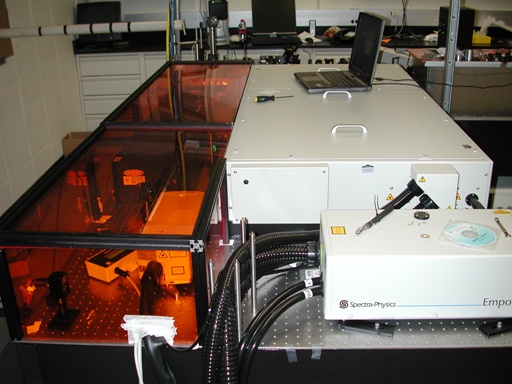Research: Difference between revisions
No edit summary |
No edit summary |
||
| Line 6: | Line 6: | ||
The backbone of any ultrafast spectroscopy lab is the laser source. The DeCamp lab has a 1kHz Spectra-Physics Spitfire XP amplifier seeded by a KMLabs Oscillator. The laser generates 3mJ, sub-40fs laser pulses for ultrafast spectroscopy. The laser output has been upgraded to produce 5+mJ at 1kHz by the construction of a home built, LN2 cooled multipass power amplifier. Using modest focusing, this laser is able to generate optical fields greater than 10^{17}\frac{W}{cm^2}. | The backbone of any ultrafast spectroscopy lab is the laser source. The DeCamp lab has a 1kHz Spectra-Physics Spitfire XP amplifier seeded by a KMLabs Oscillator. The laser generates 3mJ, sub-40fs laser pulses for ultrafast spectroscopy. The laser output has been upgraded to produce 5+mJ at 1kHz by the construction of a home built, LN2 cooled multipass power amplifier. Using modest focusing, this laser is able to generate optical fields greater than 10^{17}\frac{W}{cm^2}. | ||
[[File: | [[File:Spitfire.jpg]] | ||
== Time-resolved X-ray diffraction == | == Time-resolved X-ray diffraction == | ||
Revision as of 15:52, 26 June 2012
The DeCamp lab uses ultrafast radiation to study the sub-picosecond dynamics of complex systems. This ranges from the structural dynamics of crystalline systems to molecular dynamics in solution. The DeCamp Lab is developing several time-domain spectroscopic tools to fulfill these goals, including time-resolved x-ray scattering, time-domain THz spectroscopy, and time-domain optical spectroscopy.
Laser system
The backbone of any ultrafast spectroscopy lab is the laser source. The DeCamp lab has a 1kHz Spectra-Physics Spitfire XP amplifier seeded by a KMLabs Oscillator. The laser generates 3mJ, sub-40fs laser pulses for ultrafast spectroscopy. The laser output has been upgraded to produce 5+mJ at 1kHz by the construction of a home built, LN2 cooled multipass power amplifier. Using modest focusing, this laser is able to generate optical fields greater than 10^{17}\frac{W}{cm^2}.
